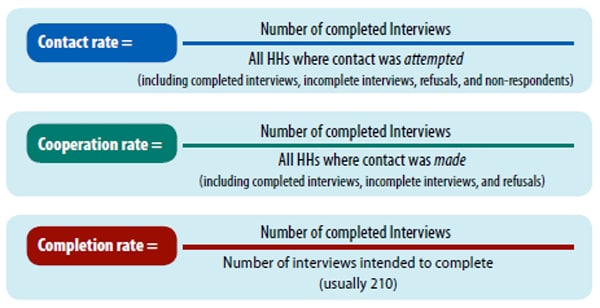At a glance
Entering data, cleaning and weighting data, and analyzing the tracking form are important tasks before analyzing CASPER data. Once the analysis is complete, share the preliminary findings with leadership and key partners within 36 hours after data collection.

Enter data
Enter questions from the questionnaire into a prepared database. Keep in mind analysis needs to be conducted in any software package that allows for multistage sample design weighting. We recommend using Epi Info™, which is user-friendly, does not require computer permissions for download, and is available free of charge. Access tutorials and guidance on Epi Info™. Data from the tracking form can be entered into any spreadsheet such as Microsoft Excel.
Clean and weight data
Data entry, cleaning, and processing are necessary to ensure the highest quality data for analysis. See the CASPER Toolkit, Section 4.1, Appendix L, and Appendix M for details and recommended steps.
Once data are merged and cleaned, assign a weight to each household that completed an interview. The weight is based on the household's probability of selection to obtain population estimates. Analysis conducted without weighting will not represent the entire sampling frame. However, you must reach 80% completion (n=168 for a traditional CASPER) to conduct weighted analysis.
Once a minimum of 80% completion is obtained, use the following weight formula:

The numerator is the total number of households in the selected sampling frame. It will be the same for every assessed household.
The denominator will potentially differ for each assessed household. If sampling has been 100% successful and interviews were completed in seven households for all 30 clusters, the denominator would be 210 (i.e., 7 * 30). Likely, obtaining seven interviews in each cluster will not be possible. Therefore, the denominator will differ depending on the cluster in which the household was selected.
Note: Households from the same cluster will have the same weight, but weights may differ between clusters.
There may be situations where a cluster is selected more than once. If so, the number of completed interviews would be divided by the number of times the cluster was selected. This ensures that the "Completed Interviews" column is always a number between 1 and 7.
See the CASPER Toolkit, Section 4.2 for more information.
Analyze the tracking form
Calculating response rates helps indicate how representative the sample is of the population within the sampling frame. Enter data from the tracking form in a spreadsheet to calculate the contact, cooperation, and completion response rates.
Contact rate: The percentage of households that complete an interview after contact is attempted. It indicates the representativeness of the sample to the population. Lower rates indicate that the field teams had to attempt interviews at many households to obtain the results.
Cooperation rate: The percentage of households that complete an interview after contact has been made. It represents both the eligibility and willingness of the community to complete the interview.
Completion rate: The percentage of completed interviews compared to the ideal number of completed interviews. It represents how close interview teams came to completing the goal of 210 interviews. A completion rate below 80% (n=168) is too low to represent the sampling frame.
To compile the tracking form data, tally the responses in each row on the tracking form. The tallied responses should be based on the final designation of the household.
For example, an interviewer may appropriately select both "no answer" and "door was answered" for a single household. Both were selected because the interviewer had to return to the household previously selected in which no one answered. Select only the final designation of "door was answered" and disregard the prior visit(s). Below are formulas for the three response rates:

For more information, please see CASPER Toolkit, Section 4.
Conduct the analysis
Once weights are assigned, weighted frequencies, percentages, and 95% confidence intervals can be calculated for each of the interview questions using Complex Sample Frequencies in Epi Info.
Only present weighted analysis for cells with 5 or more observations. Do not show cells with less than 5 observations in the final presentation of results. Applying weights provides projected estimates that can be generalized to every household in the sampling frame.
Remember
Weighted analysis does not account for any changes that may occur in the number of households between the time of the census and the time of the CASPER. Despite attempts to present accurate estimates, the reported frequencies may lack precision.
CASPER is designed for weighted frequencies, percentages, and 95% confidence intervals. Limit further analysis to adhere to the CASPER methodology. Any other estimates (such as stratified analysis) may be unstable and should be viewed with caution. Please consult with your local statistician familiar with cluster sampling methodology or reach out to CDC CASPER subject matter experts for technical assistance to discuss the feasibility of further analysis.
Multiple CASPERs
It is possible to combine CASPERs and conduct a pooled analysis through a meta-analytic approach. Please consult with your local statistician familiar with sampling methodology. You may also reach out to CDC CASPER subject matter experts for technical assistance.
Compare results
There may be a case where identical questions are asked in two or more CASPERs and the samples are independent. It is possible to compare the results from different CASPERs using t-tests and chi-square tests. The use of either test depends on whether the outcome variable is continuous or categorical.
When comparing, it is important to take into account the complex sampling design in the analysis. Please consult with your local statistician familiar with sampling methodology. You may also reach out to CDC CASPER subject matter experts for technical assistance.
Share CASPER findings
Disseminating findings is a vital component of conducting a CASPER. Share preliminary findings with leadership and key partners within 36 hours of the completion of data collection. Typically, this is done through a slide presentation to promote discussion of key findings, implementation of any recommendations, next steps, and lessons learned.
Begin the process early
You can complete several aspects of the presentation and report during the preparation phase of the CASPER. This includes:
- Deciding who will be in charge
- Gathering background information
- Creating table shells
Complete these aspects early to ensure a more timely report.
Distribute a final report widely to all interested parties
The preliminary presentation is important because it may take weeks or months to write the report and get appropriate approvals.
Consider other methods for dissemination
In addition to the report, consider other methods for disseminating findings, such as:
- Bulleted list of highlights
- Fact sheet with infographics
- Press release
These methods can ensure different audiences get information in an understandable and relevant format. See CASPER Resources for examples.
Additional Information
For more information, please see CASPER Toolkit, Section 5.
CDC is available for technical assistance and support throughout all phases of a CASPER.
